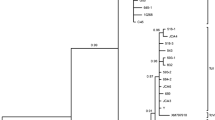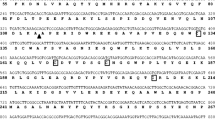Abstract
Trypanosoma cruzi, the etiologic agent of Chagas’ disease, is represented by a set of parasites which circulate between man, vectors, domestic and wild animals. Recently, our group isolated from Triatoma vitticeps strains of T. cruzi that were characterized as belonging to the Z3 phylogenetic lineage. Since very little is known about the biological and/or biochemical markers of sylvatic Z3 isolates, we have studied the protein and protease profiles of distinct Z3 isolates designated as SMM10, SMM53, SMM88, and SMM98. By means of sodium dodecyl sulfate-polyacrylamide gel electrophoresis, both quantitative and qualitative differences were observed in the protein profiles of these strains. All strains produced an acidic cysteine protease of 45 kDa, resembling cruzipain activity. The strain SMM10 synthesized an additional 55 kDa metalloprotease. Using Western blotting and anti-cruzipain antibody to detect cruzipain-like molecules, a 40-kDa reactive molecule was identified in all strains; in the strain SMM10, an 80-kDa protein was also reacted. Studies about cruzipain isoforms from sylvatic parasites could be valuable tools in the comprehension of the genetic variability in the pathogenesis of Chagas’ disease.





Similar content being viewed by others
References
Alexander J, Coombs GH, Mottram JC (1998) Leishmania mexicana cysteine proteinase-deficient mutants have attenuated virulence for mice and potentiate a Th1 response. J Immunol 161:6794–6801
Andrade SG (1999) Trypanosoma cruzi: clonal structure of parasite strains and the importance of principal clones. Mem Inst Oswaldo Cruz 94:185–187
Bontempi E, Martínez J, Cazzulo JJ (1989) Subcellular localization of a cysteine proteinase from Trypanosoma cruzi. Mol Biochem Parasitol 33:43–47
Brandão A, Fernandes O (2006) Trypanosoma cruzi: mutation in 3′-untranslated region of calmodulin gene are specific for lineages T. cruzi I, T. cruzi II and zymodeme III isolates. Exp Parasitol 112:247–252
Brisse S, Dujardin JC, Tibayrenc M (2000) Identification of six Trypanosoma cruzi lineages by sequence-characterised amplified region markers. Mol Biochem Parasitol 111:95–105
Campetella O, Martínez J, Cazzulo JJ (1990) A major cysteine proteinase is developmentally regulated in Trypanosoma cruzi. FEMS Microbiol Lett 55:145–149
Cazzulo JJ, Cazzulo Franke MC, Martínez J, Franke de Cazzulo BM (1990a) Some kinetic properties of a cysteine proteinase (cruzipain) from Trypanosoma cruzi. Biochim Biophys Acta 1037:186–191
Cazzulo JJ, Hellman U, Couso R, Parodi AJ (1990b) Amino acid and carbohydrate composition of a lysosomal cysteine proteinase from Trypanosoma cruzi. Absence of phosphorylated mannose residues. Mol Biochem Parasitol 38:41–48
Cazzulo JJ, Stoka V, Turk V (2001) The major cysteine proteinase of Trypanosoma cruzi: a valid target for chemotherapy of Chagas disease. Curr Pharmacol Des 7:1143–1156
Corrêa RR (1986) Informe sobre a doença de Chagas no Brasil e em especial no Estado de São Paulo. Rev Brasil Malariol D Trop 20:39–81
De Souza W (1995) Structural organization of the cell surface of pathogenic protozoa. Micron 26:405–430
Dias JC (1989) The indeterminate form of human chronic Chagas’ disease. A clinical epidemiological review. Rev Soc Bras Med Trop 22:147–156
Dos Reis FCG, Júdice WAF, Juliano MA, Juliano J, Scharfstein J, Lima APCA (2006) The substrate specificity of cruzipain 2, a cysteine protease isoform from Trypanosoma cruzi. FEMS Microbiol Lett 259:215–220
Dos Santos CB, Ferreira AL, Leite GR, Ferreira GE, Rodrigues AA, Falqueto A (2005) Peridomiciliary colonies of Triatoma vitticeps (Stal, 1859) (Hemiptera, Reduviidae, Triatominae) infected with Trypanosoma cruzi in rural areas of the state of Espírito Santo, Brazil. Mem Inst Oswaldo Cruz 100:471–473
Dos Santos CB, Leite GR, Sessa PA, Falqueto A (2006a) Dynamics of feeding and defecation in Triatoma vitticeps (Stal, 1859) (Hemiptera, Reduviidae, Triatominae) and its potential in the transmission of Trypanosoma cruzi. Mem Inst Oswaldo Cruz 101:543–546
Dos Santos CB, Leite GR, Ferreira GE, Ferreira AL (2006b) Natural infection of Triatoma vitticeps (Stal, 1859) with flagellates morphologically similar to Trypanosoma cruzi (Chagas, 1909) in Espírito Santo. State Rev Soc Bras Med Trop 39:89–91
Fampa P, Lisboa CV, Jansen AM, Santos ALS, Ramirez MI (2008) Protease expression analysis in recently field-isolated strains of Trypanosoma cruzi: a heterogeneous profile of cysteine protease activities between TC I and TC II major phylogenetic groups. Parasitology 135:1093–1100
Ferreira E, Souza PA, Fonseca-Filho M, Rocha I (1986) Nota sobre a distribuição geográfica do Triatoma vitticeps (Stal 1859) (Hemíptera, Reduviidae) no Estado do Rio de Janeiro, Brasil. Rev Brasil Malariol D Trop 38:11–14
Fernandes O, Santos SS, Cupolillo E, Mendonça B, Derre R, Junqueira AC, Santos LC, Sturm NR, Naiff RD, Barret TV, Campbell DA, Coura JR (2001) A mini-exon multiplex polymerase chain reaction to distinguish the major groups of Trypanosoma cruzi and T. rangeli in the Brazilian Amazon. Trans R Soc Trop Med Hyg 95:97–99
Forattini OP, Ferreira OA, Rocha e Silva EO, Rabello EX (1979) Ecological aspects of South American trypanosomiasis XIV Persistence and domicilization potential of wild triatomid populations in an intensive agricultural and cattle breeding region. Rev Saúde Pública 13:123–146
Gomes SAO, Fonseca de Souza AL, Silva BA, Kiffer-Moreira T, Santos-Mallet JR, Santos ALS, Meyer-Fernandes JR (2006) Trypanosoma rangeli: differential expression of cell surface polypeptides and ecto-phosphatase activity in short and long epimastigote forms. Exp Parasitol 112:253–262
Gonçalves TCM, Oliveira E, Dias LS, Almeida MD, Nogueira WO, Ávila-Pires FD (1998) An investigation on the ecology of Triatoma vitticeps (Stal, 1959) and its possible role in the transmission of Trypanosoma cruzi, in the locality of Triunfo, Santa Maria Madalena municipal district, state of Rio de Janeiro, Brazil. Mem Inst Oswaldo Cruz 93:711–717
Heussen C, Dowdle EB (1980) Electrophoretic analysis of plasminogen activators in polyacrylamide gels containing sodium dodecyl sulfate and copolymerized substrates. Anal Biochem 102:196–202
Hurley WL, Finkelstein E, Holst BD (1985) Identification of surface on bovine leucocytes by a biotin avidin protein blotting technique. J Immunol Methods 85:195–202
Kollien AH, Schaub GA (2000) The development of Trypanosoma cruzi in triatominae. Parasitol Today 16:381–387
Laemmli UK (1970) Cleavage of structural proteins during the assembly of the head of bacteriophage T4. Nature 227:680–685
Lima APCA, dos Reis FCG, Serveau C, Lalmanach G, Juliano L, Ménard R, Vernet T, Thomas DY, Storer AC, Sharfstein J (2001) Cystein proteinase isoforms from Trypanosoma cruzi, cruzipain 2 and cruzain, present different substrate preference and susceptibility inhibitors. Mol Biochem Parasitol 114:41–52
Lowry OH, Rozebrough NJ, Farr AL, Randall RJ (1951) Protein measurement with the folin phenol reagent. J Biol Chem 193:265–275
Macedo AM, Machado CR, Oliveira RP, Pena SD (2004) Trypanosoma cruzi: genetic structure of populations and relevance of genetic variability to the pathogenesis of Chagas disease. Mem Inst Oswaldo Cruz 99:1–12
Martínez J, Campetella O, Frasch ACC, Cazzulo JJ (1991) The major cysteine proteinase (cruzipain) from Trypanosoma cruzi is antigenic in human infections. Infect Immun 59:4275–4277
Martínez J, Cazzulo JJ (1992) Anomalous electrophoretic behaviour of the major cysteine proteinase (cruzipain) from Trypanosoma cruzi in relation to its apparent molecular mass. FEMS Microbiol Lett 74:225–229
Matteoli FP, d’Avila-Levy CM, Santos LO, Barbosa GM, Holandino C, Branquinha MH, Santos ALS (2009) Roles of the endosymbiont and leishmanolysin-like molecules expressed by Crithidia deanei in the interaction with mammalian fibroblasts. Exp Parasitol 121:246–253
Merril CR (1990) Silver staining of proteins and DNA. Nature 343:779–780
Miles MA, Souza A, Povoa M, Shaw JJ, Lainson R, Toye PJ, (1978) Isozymic heterogeneity of Trypanosoma cruzi in the first autochthonous patients with Chagas’ disease in Amazonian Brazil. Nature 272(5656):819–21
Miles M (2003) American trypanosomiasis (Chagas disease). In: G Cook, A Zumula (eds), Manson Tropical Disease. Elservier Science, London 1325–1337
Mottram JC, Brooks DR, Coombs GH (1998) Roles of cysteine proteinases of trypanosomes and Leishmania in host-parasite interactions. Curr Opin Microbiol. 1:455–460
Sajid M, McKerrow JH (2002) Cysteine proteases of parasitic organisms. Mol Biochem Parasitol 120:1–21
Santos ALS, Batista LM, Abreu CM, Alviano CS, Angluster J, Soares RMA (2001) Developmentally regulated protein expression mediated by dimethylsulfoxide in Herpetomonas samuelpessoai. Curr Microb 42:111–116
Santos ALS, Abreu CM, Alviano CS, Soares RMA (2005) Use of proteolytic enzymes as an additional tool for trypanosomatids identification. Parasitology 130:79–88
Santos ALS, d’Avila-Levy CM, Dias FA, Ribeiro RO, Pereira FM, Elias CGR, Souto-Padrón T, Lopes AHCS, Alviano CS, Branquinha MH, Soares RMA (2006) Phytomonas serpens: cysteine peptidase inhibitors interfere with growth, ultrastructure and host adhesion. Int J Parasitol 36:47–56
Santos-Mallet JR, Silva CS, Gomes SAO, Oliveira DL, Santos CL, Sousa DM, Oliveira LR, Pinheiro NL, Gonçalves TCM (2008) Molecular characterization of Trypanosoma cruzi sylvatic isolates from Rio de Janeiro, Brazil. Parasitol Res 103:1041–1045
Silveira AC, Sakamoto T (1983) Médico-social importance of Chagas’ disease in Brazil and its control. Rev Bras Malariol D Trop 35:127–134
Silveira AC, Feitosa VR, Borges R (1984) Distribuição de triatomíneos capturados no ambiente domiciliar, no período de 1975–83, Brasil. Rev Brasil Malariol D Trop 36:15–312
Soares MJ, Souto-Padrón T, De Souza W (1992) Identification of a large pre-lysosomal compartment in the pathogenic protozoon Trypanosoma cruzi. J Cell Sci 102:157–167
Souto-Padrón T, Campetella OE, Cazzulo JJ, De Souza W (1990) Cysteine proteinase in Trypanosoma cruzi: immunocytochemical localization and involvement in parasite–host cell interaction. J Cell Sci 96:485–490
Vermelho AB, Giovanni-de-Simone S, d’Avila-Levy CM, Santos ALS, Nogueira de Melo AC, Silva-Junior FP, Bom EP, Branquinha MH (2007) Trypanosomatidae peptidases: a target for drugs development. Curr Enzyme Inhib 3:19–48
Acknowledgements
We thank Luciana Reboredo de Oliveira and Simone Caldas Teves from FIOCRUZ for their excellent technical assistance. The authors wish to thank Dr. Marta Helena Branquinha for the useful critical English reviewing as well as for valuable suggestions on the manuscript. This study was supported by grants from Fundação de Amparo à Pesquisa do Estado do Rio de Janeiro (FAPERJ), Fundação Universitária José Bonifácio (FUJB), Conselho Nacional de Desenvolvimento Científico e Tecnológico (CNPq), and Fundação Oswaldo Cruz (FIOCRUZ), Rio de Janeiro.
Author information
Authors and Affiliations
Corresponding author
Additional information
S. A. O. Gomes and D. Misael contributed equally to this work.
Rights and permissions
About this article
Cite this article
Gomes, S.A.O., Misael, D., Silva, B.A. et al. Major cysteine protease (cruzipain) in Z3 sylvatic isolates of Trypanosoma cruzi from Rio de Janeiro, Brazil. Parasitol Res 105, 743–749 (2009). https://doi.org/10.1007/s00436-009-1446-5
Received:
Accepted:
Published:
Issue Date:
DOI: https://doi.org/10.1007/s00436-009-1446-5




